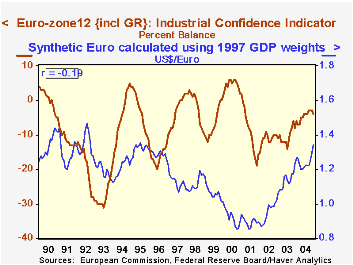 Global| Jan 06 2005
Global| Jan 06 2005European Industrial Confidence Edges Lower in December
Summary
Confidence surveys in the Euro-Zone showed some slight erosion in December, according to data issued today by the European Commission. The most widely followed measure, industrial confidence, slipped from -3 to -4 (balance of [...]

Confidence surveys in the Euro-Zone showed some slight erosion in December, according to data issued today by the European Commission. The most widely followed measure, industrial confidence, slipped from -3 to -4 (balance of favorable less unfavorable survey responses). Consumer confidence held steady at -13, and the overall Economic Sentiment Index fell 0.6%.
Press reports tended to emphasize the declines in these data, which, though modest, came in on the short side of expectations. The industrial confidence gauge, for instance, was forecast at -3 by market economists. At the same time, a quick glance at both the accompanying chart and table shows that the latest confidence data are far from weak by recent historical comparisons. The "decline" in Economic Sentiment still left it above the 2004 average and more than 3% above the year-ago level. Industrial confidence, at -4 in December, was similarly firmer than the year's average of -5 and the December 2003 reading of -8. Thus, it would seem important not to give excessive weight to this latest one-month movement in judging prospects for the European economy early in the new year.
Another issue discussed in press reports as impacting economic sentiment and confidence is the exchange rate. Since trade has very significant role in European economic activity, some argue that these survey results reflect the recent strength in the euro, which would be expected to slow those economies. We agree that's a logical position, but the actual performance of exchange rate and sentiment data don't bear this out. There is virtually no correlation between the euro and either the economic sentiment index or industrial confidence. As evident in the graph, for some periods, it does appear that swings in the currency drive sentiment, while at other times, the causation must run the other way. The correlation ratio is negative overall in the last 15 years, but over the last three years, currency and sentiment have been positively related. This is another example that seemingly straightforward rules of thumb about economic relationships don't always pan out.
| Dec 2004 | Nov 2004 | Oct 2004 | Dec 2003 | 2004 | 2003 | 2002 | |
|---|---|---|---|---|---|---|---|
| Economic Sentiment (Long-Term Average = 100)* | 100.3 | 100.9 | 101.4 | 97.2 | 100.1 | 93.5 | 94.4 |
| Industrial Confidence (Balance)* | -4 | -3 | -3 | -8 | -5 | -10 | -11 |
| Consumer Confidence (Balance)* | -13 | -13 | -14 | -16 | -14 | -18 | -11 |
| Exchange Rate ($/Euro) | 1.3408 | 1.2991 | 1.2490 | 1.2286 | 1.2433 | 1.1309 | 0.9449 |
Carol Stone, CBE
AuthorMore in Author Profile »Carol Stone, CBE came to Haver Analytics in 2003 following more than 35 years as a financial market economist at major Wall Street financial institutions, most especially Merrill Lynch and Nomura Securities. She had broad experience in analysis and forecasting of flow-of-funds accounts, the federal budget and Federal Reserve operations. At Nomura Securities, among other duties, she developed various indicator forecasting tools and edited a daily global publication produced in London and New York for readers in Tokyo. At Haver Analytics, Carol was a member of the Research Department, aiding database managers with research and documentation efforts, as well as posting commentary on select economic reports. In addition, she conducted Ways-of-the-World, a blog on economic issues for an Episcopal-Church-affiliated website, The Geranium Farm. During her career, Carol served as an officer of the Money Marketeers and the Downtown Economists Club. She had a PhD from NYU's Stern School of Business. She lived in Brooklyn, New York, and had a weekend home on Long Island.





